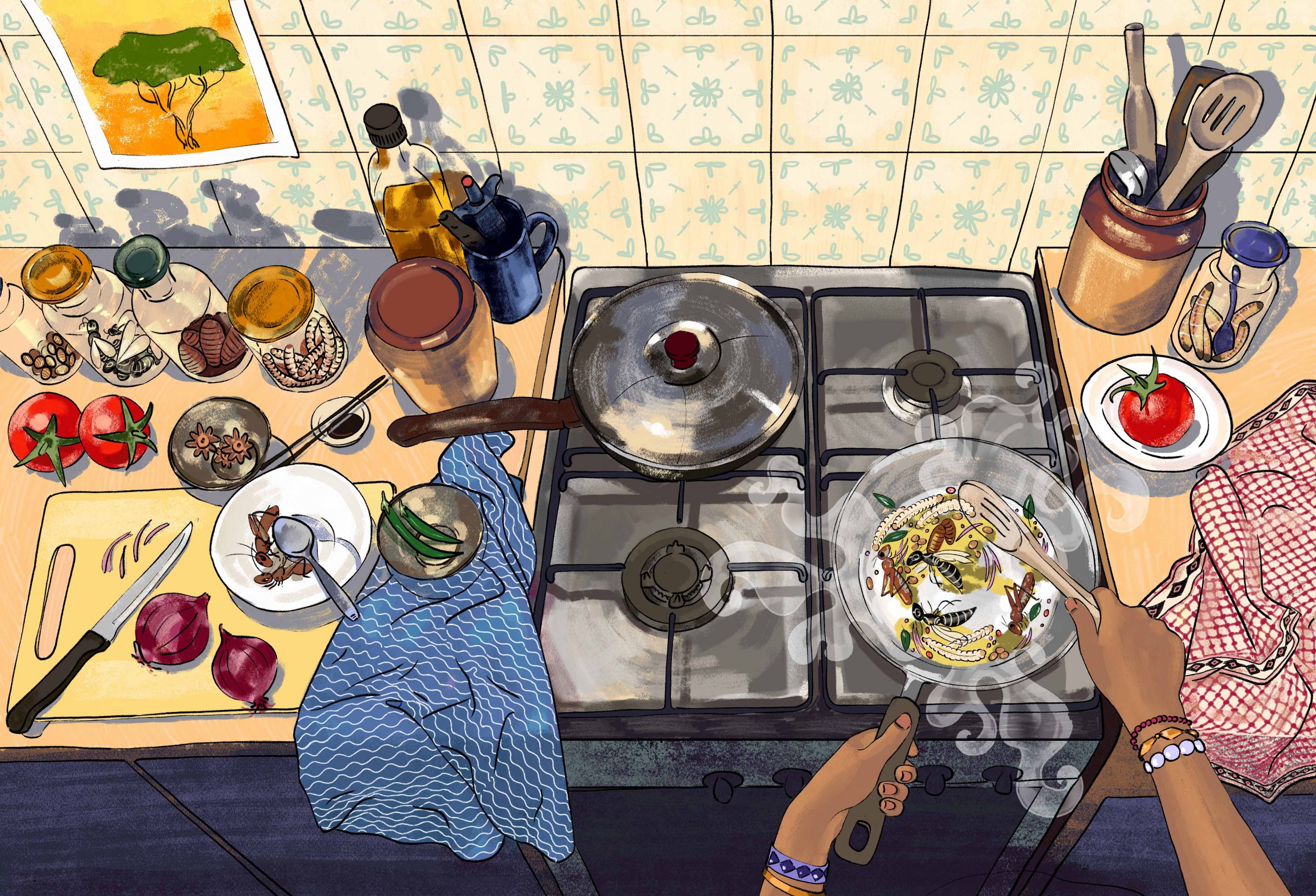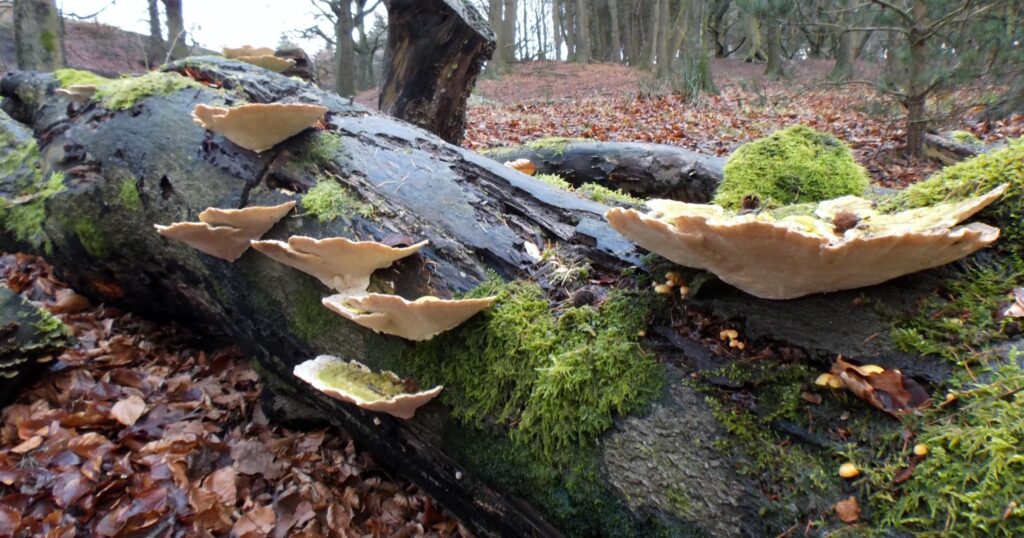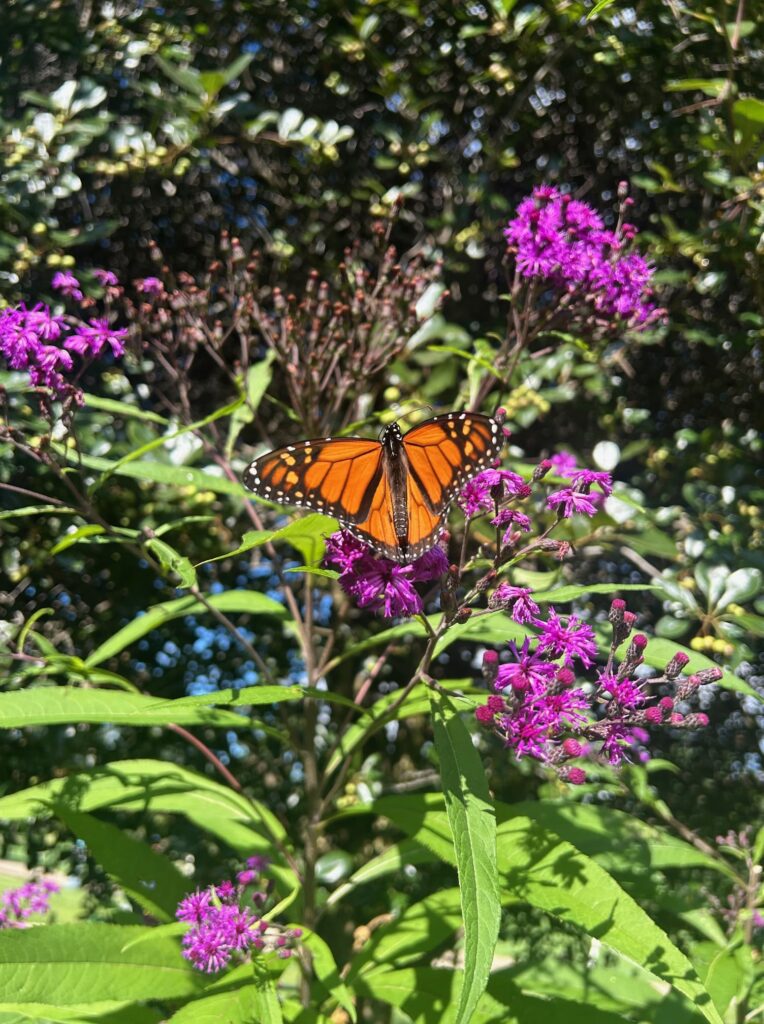“As food, caterpillars are regulars in the village, but meat is a stranger.”
− A Yansi saying from the Democratic Republic of the Congo (1)
The practice of using insects as a food source is older than you might think, and is intertwined with humanity’s food culture, both in the past and present, and with clues to the future.
The story begins far back in evolutionary time. To set the stage: it is around the same time as the extinction of the dinosaurs, and warming global temperatures are causing a radiation and diversification of flowering plants. Important pollinators like insects follow, as do insectivorous vertebrates (insectivorous: consuming insects as food, predominantly used for non-human animals). The first primates, the common ancestor of all apes, monkeys, and human beings today, likely evolved around this time too, 50 million years ago. This scrappy ancestor of ours was likely insectivorous as well. Like the aye aye, tamarins, and the marmoset, several smaller primate species living today remain predominantly insectivorous.
Our story flashes forward down the human evolutionary line to the genus Australopithecus, evolving shortly after our split from our last common ancestor with the chimpanzees six million years ago. These ‘upright walking apes’ have specialisations to furnish a relatively newer innovation—walking on two legs. Bipedalism requires major adaptations in the hip joints, back, knees and feet. Many Australopithecines also show another important specialisation—the use of tools.

Tool use and diet
The archaeological site of Swartkrans is a limestone cave in the Cradle of Humankind World Heritage Site in South Africa, in which fossils have accumulated over time. It is the site of some of the oldest known bone tools used by the Australopithecine, A. robustus. Of particular interest here are highly polished bone tools around the size of a sausage. They have a wear pattern on the ends, consisting of fine striations parallel to their long axis. This pattern, combined with the fact that it was found on so many tools in one area, rules out the possibility of it being caused by non-human agents like weathering or gnawing by hungry carnivores. They were human tools!
These tools were generally thought to have been used to dig up tubers, which continue to be an energetically important food source today. In 2001, researchers Backwell and d’Errico took a second look. They created experimental tools, used them for various tasks, and then used microscopy to compare the resultant wear patterns with the archaeological specimens. The surface modifications on the artefacts matched those of tools used to dig into termite mounds. Termite mounds consist of uniformly sized soil that has been finely sorted, and so unlike digging into rocky uneven soil for tubers, fine parallel wear is produced. In case of digging for tubers, the tool needs to be manoeuvred in different directions—so the pattern showed scarring that was deeper and multi-directional. Further studies have suggested a multi-use hypothesis: early humans might have used the bone tools for termite foraging in addition to digging for tubers, processing hide and harvesting bark.
In the habitat of early hominids, social insects like termites would have been abundant and easy to locate, making them a viable, nutritious addition to the diet. Even as Homo sapiens has evolved, that has remained true. The fact that early humans likely had insects in their diet demonstrates what a perfectly natural dietary component they are. A diet incorporating insects, with the appropriate cultural and social knowledge of which to eat and when, is as natural as a diet eating shrimp and lobster, insects’ arthropod cousins.
Choosing what to eat
Today, more than 2000 species of edible insects are consumed by human beings. The UN’s Food and Agricultural Organisation (FAO) estimates that insects make up the traditional diets of around two billion people.
For both hominid ancestors and modern foragers and cultivators, several considerations are made about which edible insects are eaten. What species of insects are consumed depends generally on how big they are and how many are available. To make the effort to catch them worthwhile, they must be easy to locate, preferably in large quantities. Beetles (Order Coleoptera) are the most diverse insect group, so, unsurprisingly, they are also the most commonly consumed. Caterpillars, bees, wasps, ants, and termites, along with grasshoppers and crickets, are among some of the other commonly eaten insects.
There is a rich history of edible insects in traditional and street food culture in tropical regions worldwide. Insects are consumed at various life stages and may be eaten raw, fried, boiled, roasted or ground. Edible insect consumption was widespread among pre-colonial populations in most of Asia, Africa, and large parts of South America.
Mopane worms (Gonimbrasia belina), the brightly coloured caterpillar of the Emperor moth, have been eaten for generations across Southern Africa. They are available seasonally and are generally handpicked, often by women and children. The caterpillars are gutted, boiled and sun-dried, which can preserve them for several months. Depending on how they are prepared, they can taste like everything from tea to burnt steak. Mopane worms are a profitable harvest, both nutritionally and economically, and they are increasingly beingcommercialised.


In Australia, witchetty (witjuti) grubs refer to the large, white larvae of several moths and beetles. It is most commonly used to refer to the larvae of the cossid moth Endoxyla. They are eaten raw or lightly cooked and are an important ‘bush food’ to Aboriginal Australians.
Fried spiders, while not technically insects, are a Cambodian delicacy. The practice started out as a ‘hunger food’ in response to crippling food scarcity during the bloody regime of the Khmer Rouge. The spider is the Thai zebra tarantula, which are safe to eat, cook quickly and have high amounts of protein and zinc. Today, the spiders are a popular deep-fried street food and tourist attraction. Worryingly, increased deforestation has threatened the spiders’ natural habitat, leading to concerns over the sustainability of this food source.
Several edible insects are also ‘pests’ on crops. In Burkina Faso, the shea caterpillar (Cirina butyrospermi), known colloquially as ‘chitoumou’, feeds off trees grown to produce shea butter. The seasonal collection and sale of these edible caterpillars represent a valuable income source for women in the region. The caterpillars are an important source of animal protein. If you wish to eat them immediately, the larvae may be boiled in water, and fried in butter, but the caterpillars may also be boiled and sun-dried to preserve them for sale in markets.
While wild-harvested edible insects are important supplements to traditional diets, they are often seasonal.

In central Japan, the edible wasp Vespula flaviceps is a delicacy. The wasps are traditionally gathered in late autumn when the nests are the largest. The process of collecting the wasps involves first creating a bait of meat to attract the carnivorous worker wasps. When a wasp is attracted, it is offered a wasp-sized piece of meat attached with a marker, made of cotton wool or plastic. If this process is successful, the wasp is followed through the forest to locate the nest. Smoke is used to sedate the wasps, and the nest is dug out for harvesting.
The harvesting is time-consuming, energy-intensive, and following the wasps across the forested mountain landscape is dangerous. Today, there has been a push for domestication, with wasp collectors relocating nests to human-made hive boxes.
Domestication is often expensive and unsuccessful, but, in this case, economics is not the primary motivator for keeping the wasps. The species remains deeply significant to the food culture, with annual festivals organising competitions for the biggest wasp nest, either harvested or cultivated. Celebrations of the wasp harvest involve various delicacies, and an opportunity to exchange knowledge about collection and cultivation.
Nutritional benefits
Edible insects present an important nutritional opportunity in a changing world. World hunger is on the rise, affecting 690 million people worldwide (2).
The world’s population is estimated to be well over nine billion by 2050. Increasing our livestock production to meet these demands would increase the pressure for land and freshwater and release increased amounts of the greenhouse gases associated with conventional meat sources.

Meeting the challenges of feeding humanity, today and in the future, will require a restructuring of our global food production systems. Edible insects are rich in protein and have an energy content similar to other sources of meat like chicken and beef. Excluding domesticated sources, fat is hard to come by in the natural world, and edible insects are an important source of the nutrient. The specific nutrient profile varies across insect species and can depend on what the insects are fed on, their stage of development, sex, and environmental factors. A higher fat content is found in insect larvae and soft-bodied species like termites, while crickets and grasshoppers, having a hard exoskeleton have lower fat levels. Although data on the exact quantities is limited, edible insects are also sources of micronutrients like zinc, calcium and vitamin A. Iron levels in insects also tend to be higher than most plant-based alternatives to meat protein.
Insects in a changing world
While humanity’s ancestors might have subsisted by wild-foraging on insects for their diets, we may not be so lucky. Worldwide, insects are facing an apocalypse. Recent studies have predicted that insects could vanish within a century at their current rate of decline. The main cause of this decline? The intensification of agriculture and pesticide use. Traditional indigenous knowledge of the management of these insects and their habitat is also fast disappearing.
To avoid the unsustainable overexploitation of already-imperilled wild edible insect populations, the FAO proposes a solution—the rearing of insects for food and animal feed. Better knowledge of insect ecology, life cycles, and ecosystem dynamics could help increase efficiency while maintaining nutritional quality.
Small-scale rearing of insects has a lighter environmental impact than typically Western forms of animal protein. Demand for animal protein increases the demand for grain and protein as fodder for livestock. Around six kilograms of plant protein are needed to feed livestock to produce one kilogram of high quality animal protein. Being cold-blooded, insects can convert feed into increased body mass more efficiently—crickets can convert feed to meat with an efficiency two, four and twelve times that of chicken, pigs and cattle, respectively.
Edible insects produce fewer levels of greenhouse gases than most livestock and require considerably less water. As it can be done in vertically stacked boxes, insect-rearing does not need extensive land-clearing to expand production. (A necessary addendum: further research is needed into potential allergens associated with edible insects and to ensure that environmental benefits of insect rearing are retained when scaled up.)
Insects also provide household level livelihood opportunities, as this ‘mini livestock’ already forms a part of street food culture in many parts of the world. In urban and rural areas, involvement in cultivation, processing and sale of insects can provide a source of nutrition and extra income to marginalised groups like women and the landless.
What’s stopping us?
At this point, it would be worthwhile to consider why we don’t already have insects as a part of our collective diet. Developing countries are seeing an increasing ‘westernisation’ of their diets. Western countries historically tend to look upon the practice as taboo (see: any season of the reality show Fear Factor). The reasons are probably twofold—the climate in northern latitudes is colder and necessitates eating meat. By comparison, in the tropics, several edible species might be found all year round, and harvests can be more predictable.
Climate might explain the lack of eating insects, but not the associated disgust. The origin of human disgust is all too often dependent on culture, on history, mobility, and, in this case, colonialism. The consumption of insects by indigenous peoples was often looked upon as further evidence of their differences from the colonialist’s ideal, and was used as a justification for the dehumanisation and atrocities that followed. Disgust is often used to maintain hierarchies. Similar problems arise out of dominant perceptions of class, caste and tribe, where associated insecteating is looked down upon, leading to the loss of these food practices.
Food and power
While considering how we can use the opportunity (both nutritional and environmental) that insects provide us, it is equally important to recognise that overhauling our food production systems provides us with the opportunity to not simply reinforce the power imbalances that brought this present crisis upon us. Resource extraction must benefit the people most threatened by food insecurity.
Since 2010, insect products are increasingly being sold online as the edible insect movement has gained traction in predominantly white countries. They are priced far higher than meat products, limiting their access from most of the world. Further, their increasing popularity among those with resources drives prices up, meaning that traditional consumers eventually may no longer have access.

Edible insect products in the market reveal little information on the social and ecological contexts of their production. A more democratic approach would involve consideration of who produces, controls and benefits from this resource. Visualising a more democratic food production system that truly benefits the underprivileged will depend on how the profits are distributed within the trade chain.
Food challenges are not due to a lack of food but due to structural inequalities. What structures will we be reinforcing through our food choices, both old and new?
Footnotes
(1) Muyay, T. 1981. Les insectes comme aliments de l’homme: Serie II, Vol. 69. Democratic Republic of the Congo, Ceeba Publications.
(2) FAO, IFAD, UNICEF, WFP and WHO. 2020. The State of Food Security and Nutrition in the World 2020. Transforming food systems for affordable healthy diets. Rome, FAO.
Further reading
Dobermann, D., J. A. Swift and L. M. Field. 2017. Opportunities and hurdles of edible insects for food and feed. Nutrition Bulletin 42(4): 293–308.
Payne, C. L. R., A. Badolo, S. Cox, B. Sagnon, D. Dobermann, C. Milbank, P. Scarborough et al. 2020. The contribution of ‘chitoumou’, the edible caterpillar Cirina butyrospermi, to the food security of smallholder farmers in southwestern Burkina Faso. Food Security 12(1): 221–234.
Müller, A., J. Evans, C.L.R. Payne and R. Roberts. 2016. Entomophagy and power. Journal of Insects as Food and Feed 2(2): 121–136.






